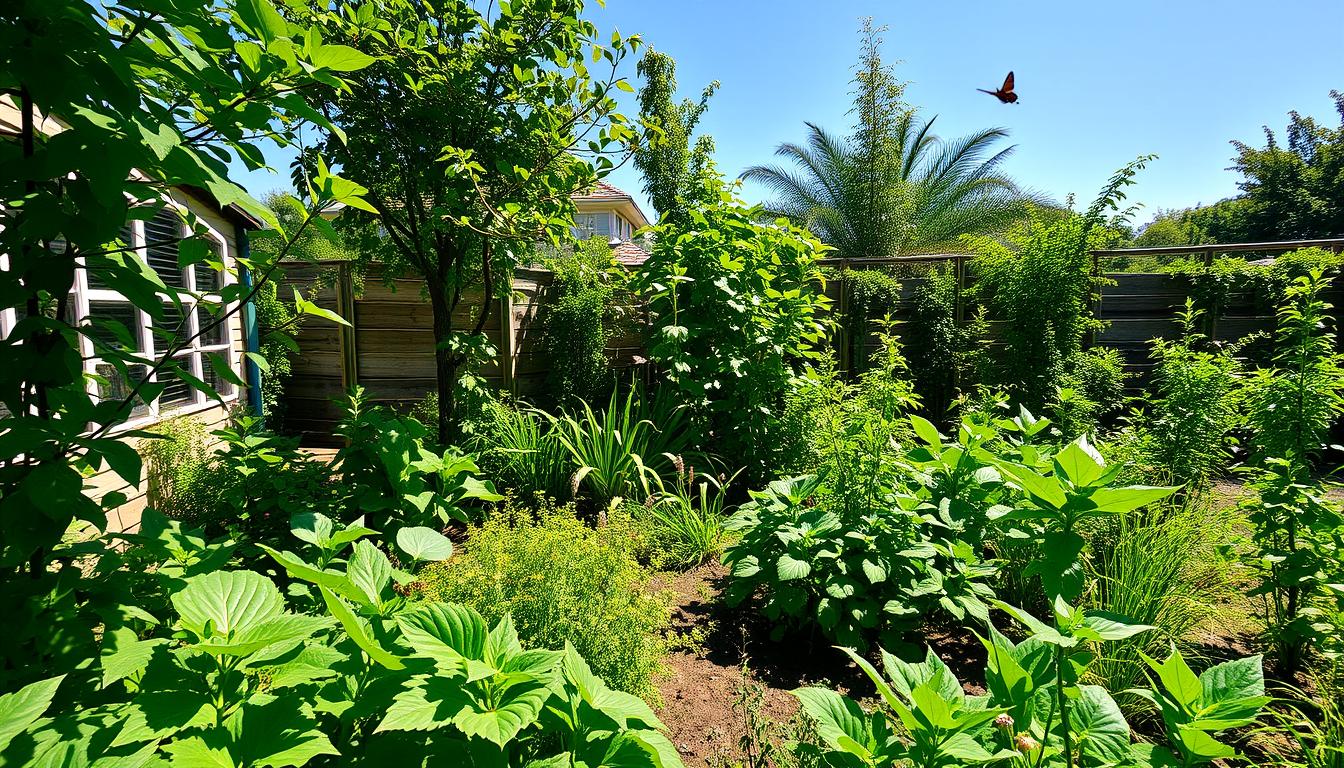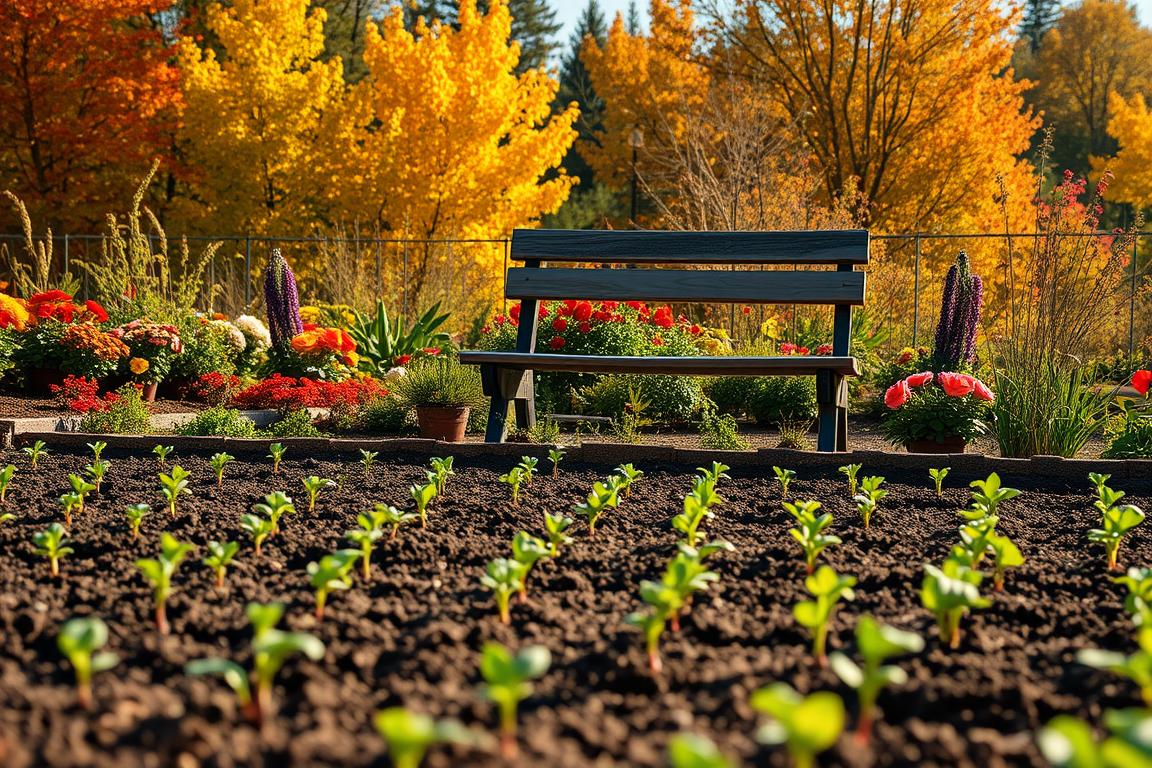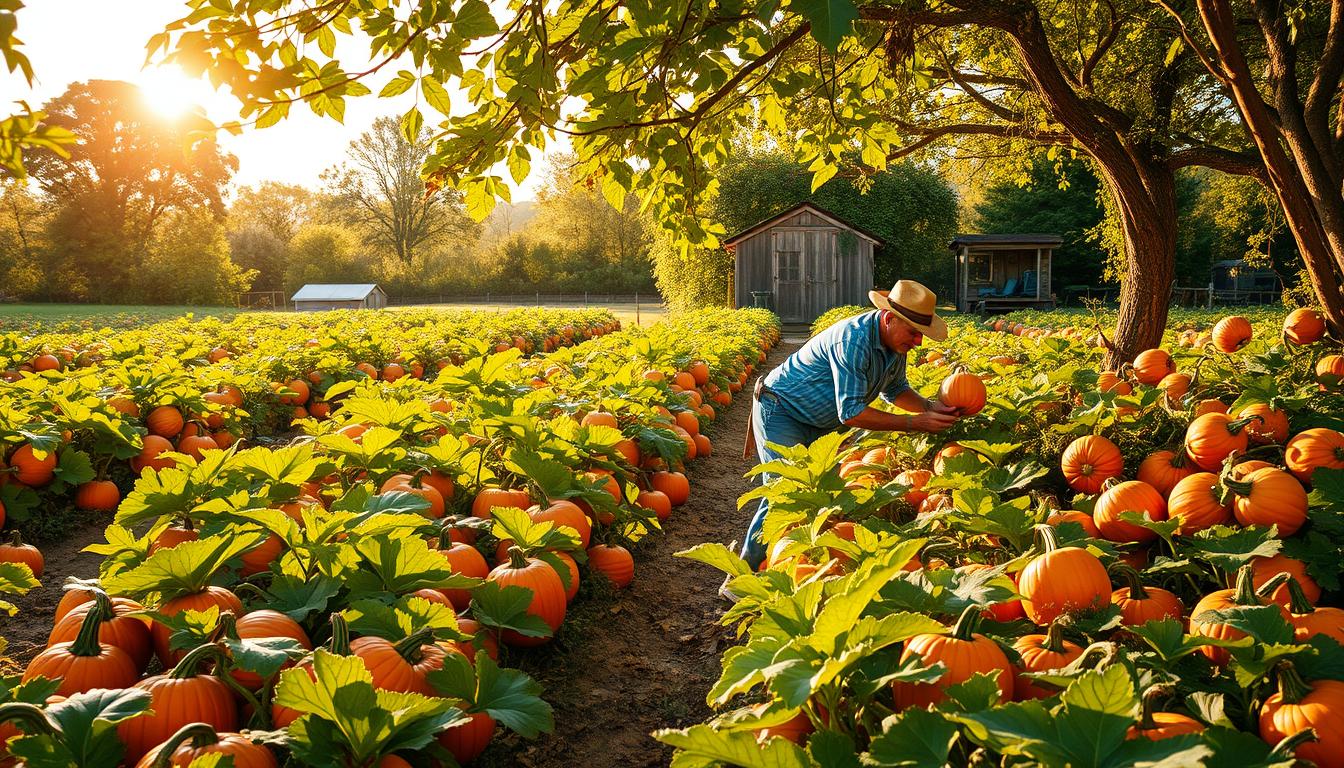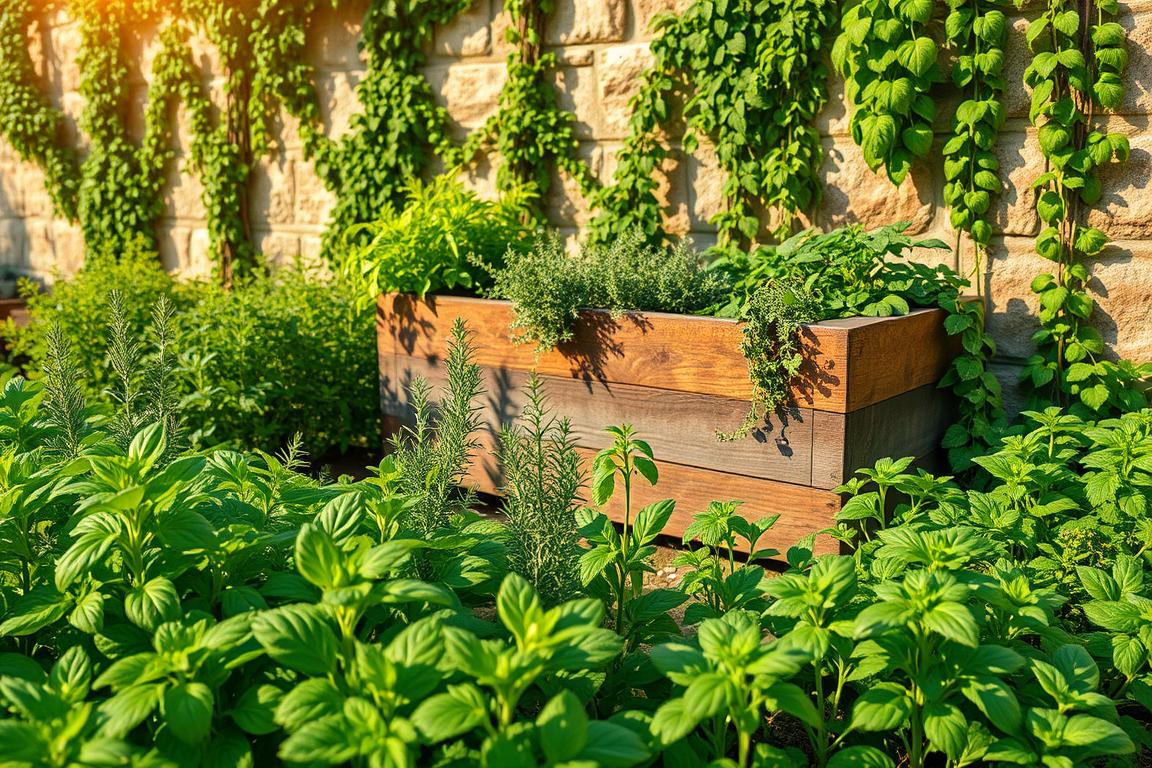In today’s world, caring for the environment is key. Eco-friendly landscaping is all about working with nature. It makes our outdoor spaces lively and good for us and the planet.
By using green gardening methods, we can turn our yards into places that help local animals and save resources. This makes our environment healthier and stronger.
Eco-friendly landscaping is about mixing the natural and built worlds well. It uses resources wisely and keeps ecosystems safe. Our outdoor areas become beautiful, easy-to-care-for spots. Here, bees and butterflies remind us of the beauty of nature and our connection to it.
Key Takeaways
- Eco-friendly landscaping promotes sustainable gardening practices that reduce the need for fertilizers and pesticides.
- Native plants with deep root systems aid in water conservation, crucial for sustainable landscaping in dry climates.
- Permeable hardscapes and water-efficient xeriscapes contribute to the eco-friendliness of a landscape.
- Strategically planted trees can enhance a home’s energy efficiency and reduce utility costs.
- Sustainable landscaping can lower a property’s carbon footprint and provide health benefits for homeowners.
Understanding Sustainable Landscape Design Principles
Sustainable landscape design aims to make outdoor spaces both beautiful and functional. It also tries to lessen harm to the environment. This approach has key principles that help gardeners and designers create greener spaces.
Benefits of Water-Wise Landscaping
Water conservation, or xeriscaping, is a big part of sustainable landscaping. It uses plants that need less water and smart irrigation systems. This cuts down water use a lot.
A survey showed that using rainwater and native plants are very popular. Landscape architects gave them high ratings.
Impact of Climate Change on Garden Design
As the climate changes, garden designers must adapt. They choose plants that can handle new conditions and make landscapes more resilient. Native plants were seen as very important.
Creating Harmony with Local Ecosystems
Sustainable design also focuses on working with local ecosystems. It uses native plant species and avoids harmful chemicals. This helps support local wildlife and keeps the ecosystem balanced.
Low-maintenance landscapes, often with native plants, are very popular. They were given an 85% popularity rating.
“Sustainable landscaping fosters healthier, more livable spaces that encourage outdoor activity and community interaction, aligning with the values of residents in the Central Coast.”
Native Plants: The Foundation of Natural Gardens
Designing eco-friendly landscapes starts with choosing native plant species. These plants fit well with the local climate and soil. They need less water, food, and pest control than non-native plants. By using native plants, we can make gardens that support wildlife habitats and local biodiversity.
Using native flora has many benefits. These plants have grown to thrive in the local climate and soil over time. They are more resilient and need less care. This helps save water and reduces the use of harmful chemicals, making our gardens healthier and more biodiverse.
| Native Plant Example | Ecosystem Benefits |
|---|---|
| Hibiscus | Provides nectar for hummingbirds and butterflies, and food for caterpillars |
| Crepe Myrtle | Attracts a variety of pollinators and offers shelter for birds |
| Jasmine | Serves as a host plant for several species of butterflies and moths |
Choosing native plant species lets us create beautiful gardens that are also wildlife habitats. These gardens support the balance of local ecosystems. They add beauty and help keep our environment healthy and sustainable.
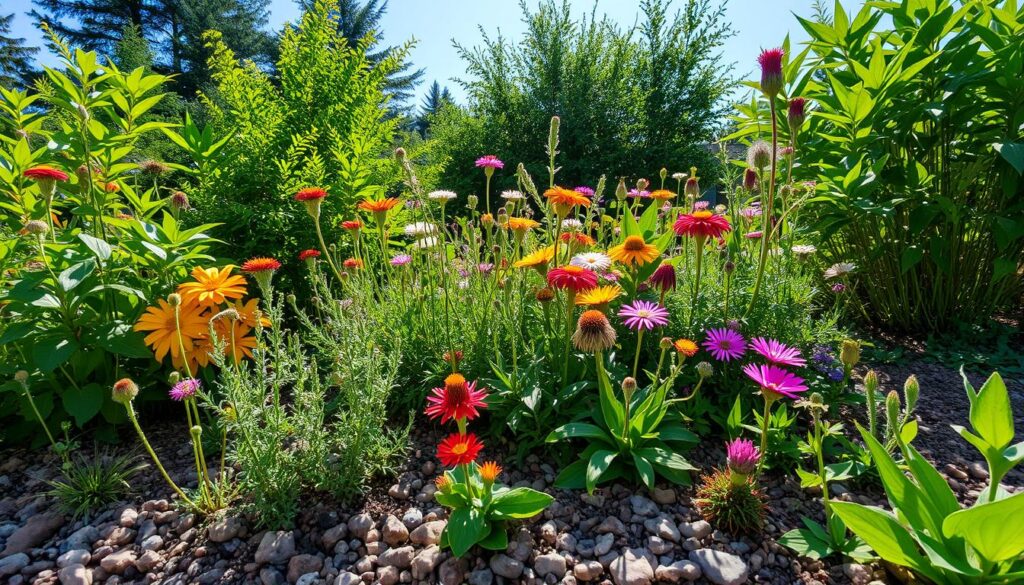
“When we choose native plants, we’re not just creating a pretty yard – we’re creating an entire living, breathing ecosystem that supports local wildlife and contributes to the overall health of the environment.”
Eco-Friendly Landscaping: Essential Techniques and Practices
Using eco-friendly landscaping is key for a sustainable outdoor space. It includes natural pest control and water saving methods. These practices are good for the environment and make your garden healthier and more beautiful over time.
Natural Pest Control Methods
Organic pest control is a big part of eco-friendly landscaping. It uses beneficial insects and natural repellents to fight pests. This way, you avoid harmful chemicals and keep your garden’s ecosystem balanced.
Water Conservation Strategies
With climate change and water shortages, saving water in landscaping is vital. Using drip irrigation and smart controllers cuts down water use. Adding native plants and mulching also helps save water, making your garden more sustainable.
Soil Health Management
Healthy soil is essential for a good garden. Composting yard and kitchen waste makes soil rich in nutrients. This reduces the need for synthetic fertilizers and improves soil health. It also helps the environment by reducing waste.
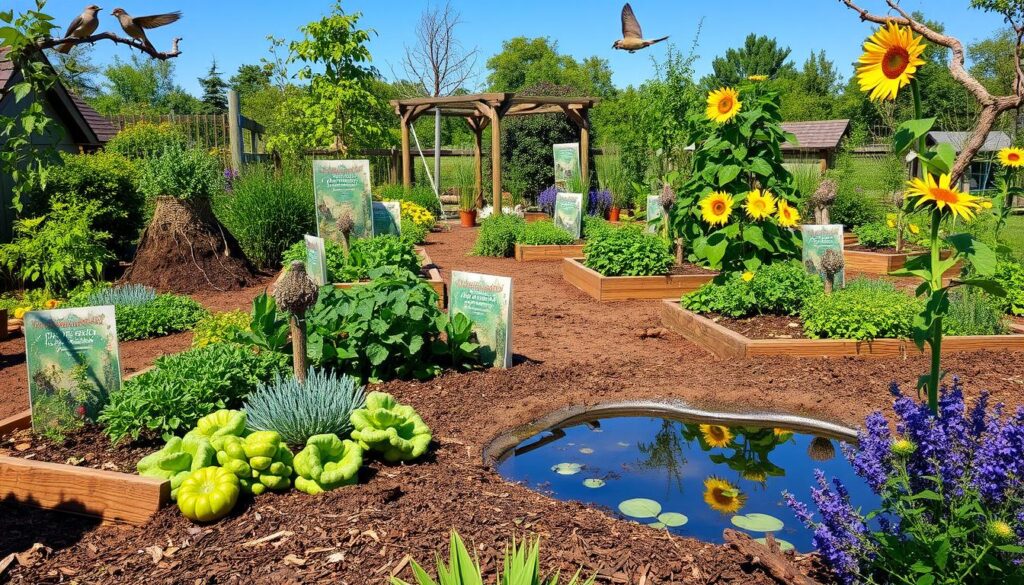
By using these eco-friendly landscaping methods, you can make a beautiful and sustainable outdoor space. It’s good for the environment and fun for you. These practices show you care about the land and nature.
Sustainable Hardscaping Solutions
Sustainable hardscaping is key in eco-friendly landscaping. It uses materials and methods that are good for the planet. This approach makes outdoor spaces look great and helps the environment.
Permeable paving is a big deal in sustainable hardscaping. These surfaces let water soak through, cutting down on runoff. They also help groundwater and prevent erosion.
Using recycled materials like reclaimed brick or plastic pavers is also good. It cuts down on waste and saves resources. Plus, getting materials from nearby places reduces carbon emissions.
Sustainable hardscaping also means using green infrastructure. This includes permeable paving, native plants, and rain gardens. These features manage stormwater well.
Sustainable hardscaping is not just about aesthetics; it’s about designing with the environment in mind, creating outdoor spaces that are both beautiful and ecologically responsible.
By choosing sustainable hardscaping, we can make outdoor spaces that are good for the planet. Using the right materials and designs helps us create a greener future.
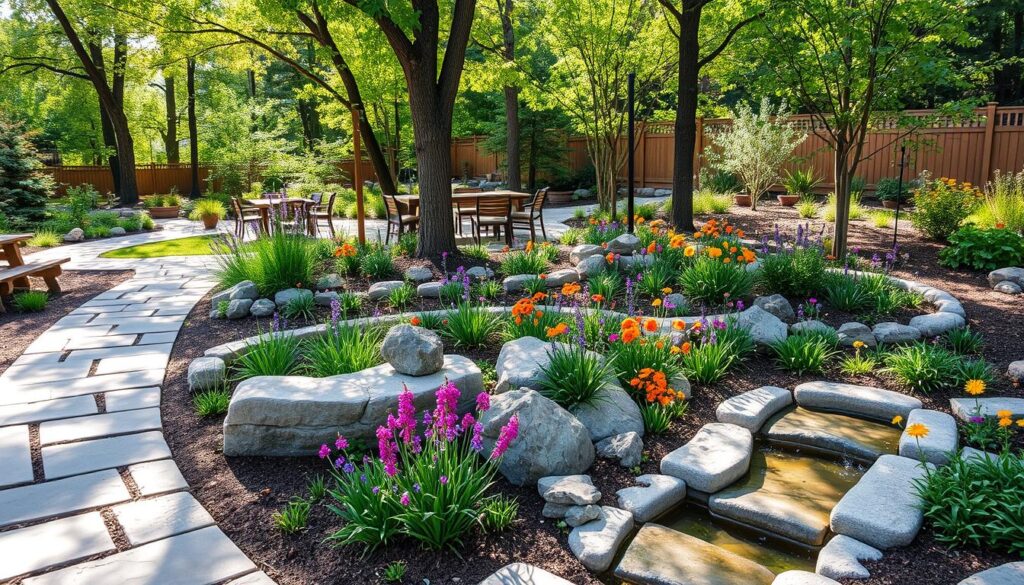
Creating Wildlife-Friendly Gardens
Turning outdoor areas into homes for pollinators, birds, and other animals is key in wildlife-friendly gardening. By designing gardens for pollinators and creating different habitats, homeowners help protect nature and support local wildlife.
Pollinator Garden Design
Creating a pollinator-friendly garden starts with choosing native plants. These plants offer nectar and pollen for bees, butterflies, and other helpful insects. Plants like purple coneflowers, bee balm, and liatris attract many pollinators. Zinnias and sunflowers add color and nectar, helping these important garden friends.
Habitat Creation for Local Species
Wildlife-friendly gardens do more than just have plants. They also include features for different local species. Birdhouses, insect hotels, and brush piles provide shelter and nesting spots for birds, insects, and small mammals. Native grasses, ferns, and berry bushes like elderberry help support a variety of wildlife.
Water Features for Wildlife
No wildlife-friendly garden is complete without water. Bird baths, ponds, and shallow pools draw in frogs, toads, turtles, and bats. These water features offer a place for animals to drink and help keep the garden’s ecosystem balanced.
FAQ
Q: What is eco-friendly landscaping?
A: Eco-friendly landscaping makes outdoor spaces that are good for the environment. It makes places that are healthy for us and last long. It uses natural and built elements wisely, saving resources and protecting nature.
Q: What are the benefits of water-wise landscaping?
A: Water-wise landscaping, or xeriscaping, saves water by using plants that don’t need much water. It also uses rain barrels and smart irrigation systems. This approach cuts down on carbon emissions and makes beautiful outdoor areas.
Q: How does climate change affect landscaping?
A: Climate change changes how plants grow and brings more extreme weather. Landscapers must pick plants that can handle different weather. They also need to plan for extreme weather to protect their designs.
Q: What are the benefits of using native plants?
A: Native plants need less water and care because they fit well in local environments. They help local animals by providing food and shelter. Using native plants saves water and supports local wildlife.
Q: What are some eco-friendly landscaping practices?
A: Good eco-friendly landscaping uses natural fertilizers and pest control. It saves water with smart irrigation and mulching. It also improves soil health by composting yard and kitchen waste.
Q: What are sustainable hardscaping solutions?
A: Sustainable hardscaping uses materials like reclaimed brick and local stone for paths and walls. These materials are good for the environment and help prevent erosion. They also help keep water underground.
Q: How can I create a wildlife-friendly garden?
A: A wildlife-friendly garden is a safe place for animals and pollinators. It has native plants for bees and butterflies. It also has birdhouses, insect hotels, and water sources for animals.


